
Chapter 11
Current Liabilities and Payroll
Chapter 11: Overview
The chapter begins with the definitions of current and long-term liabilities. Accounting for current
liabilities is first discussed and illustrated. The current liabilities of known amounts covered in this
chapter are accounts payable, sales tax payable, income tax payable, unearned revenue, short-term notes
payable, and current portion of long-term notes payable.
Accounting for payroll is then presented. Gross pay, net pay, and employee payroll withholding
deductions (income tax, FICA tax, and optional withholdings) are discussed. A W-4 form and a payroll
register are illustrated. The journal entries for employee payroll are illustrated. Employer payroll taxes
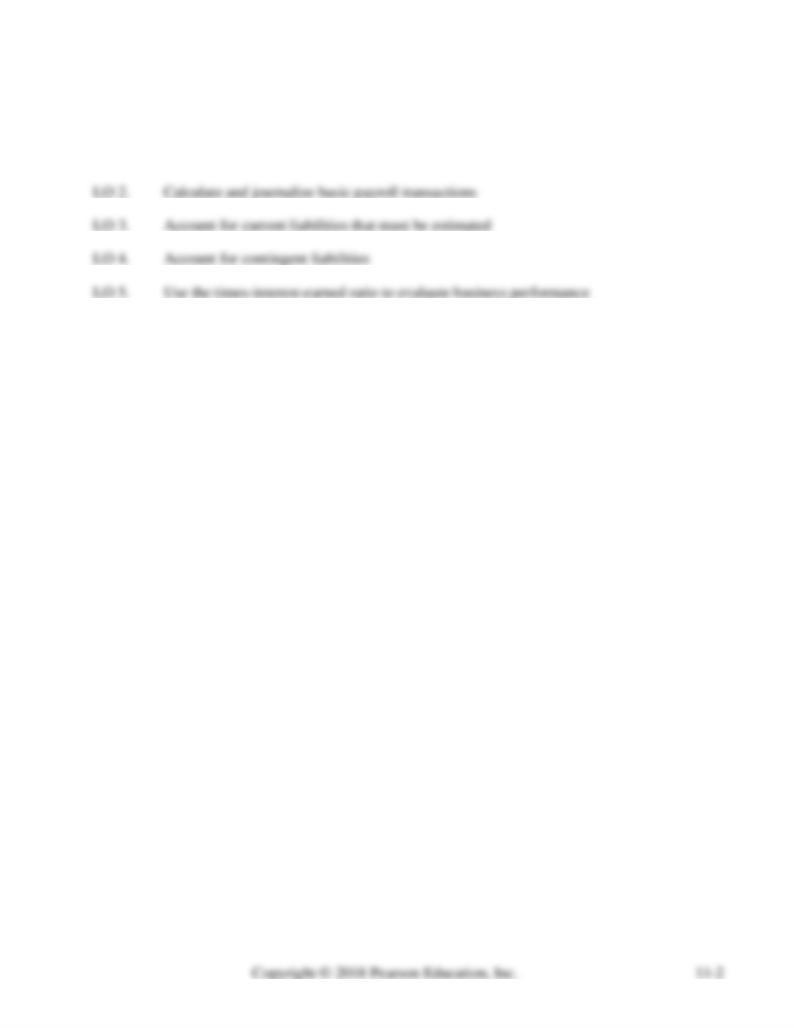
Chapter 11: Learning Objectives
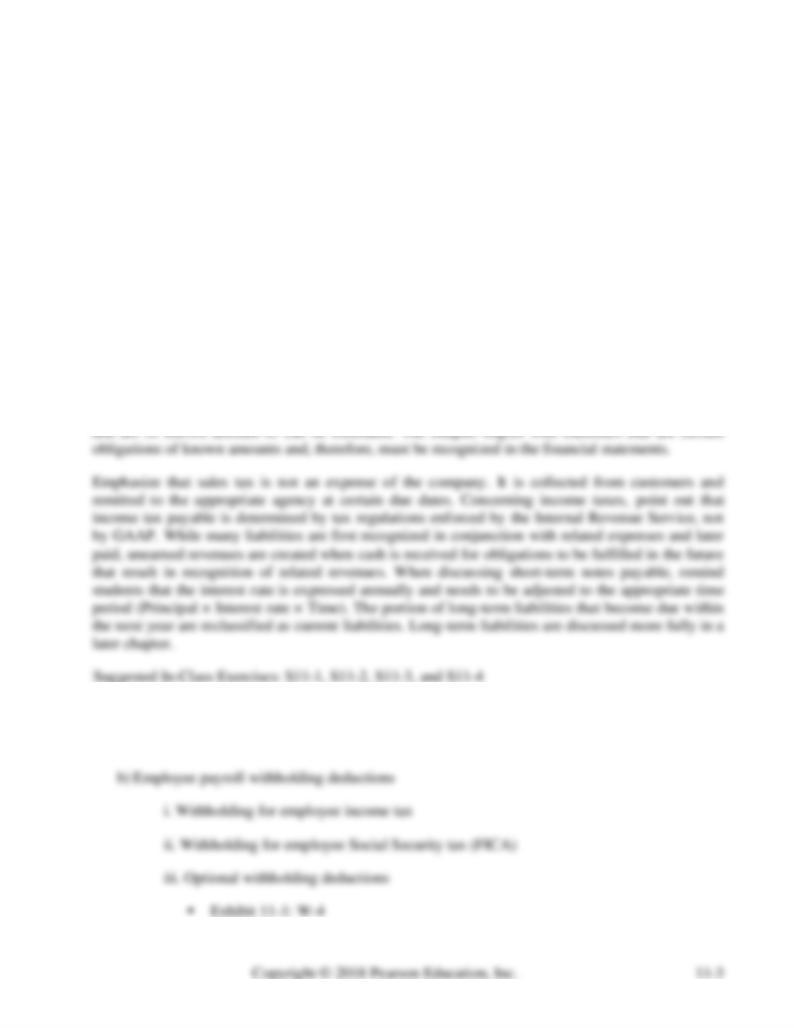
Chapter 11: Teaching Outline with Lecture Notes
LO 1. Account for current liabilities of known amount
a) Classification of liabilities as current or long-term
b) Accounts payable
c) Sales tax payable
d) Income tax payable
e) Unearned revenues
f) Short-term notes payable
g) Current portion of long-term notes payable
Lecture Notes: As noted later in the chapter, liabilities are recognized if they are at least probable
LO 2. Calculate and journalize basic payroll transactions
a) Gross pay and net (take-home) pay
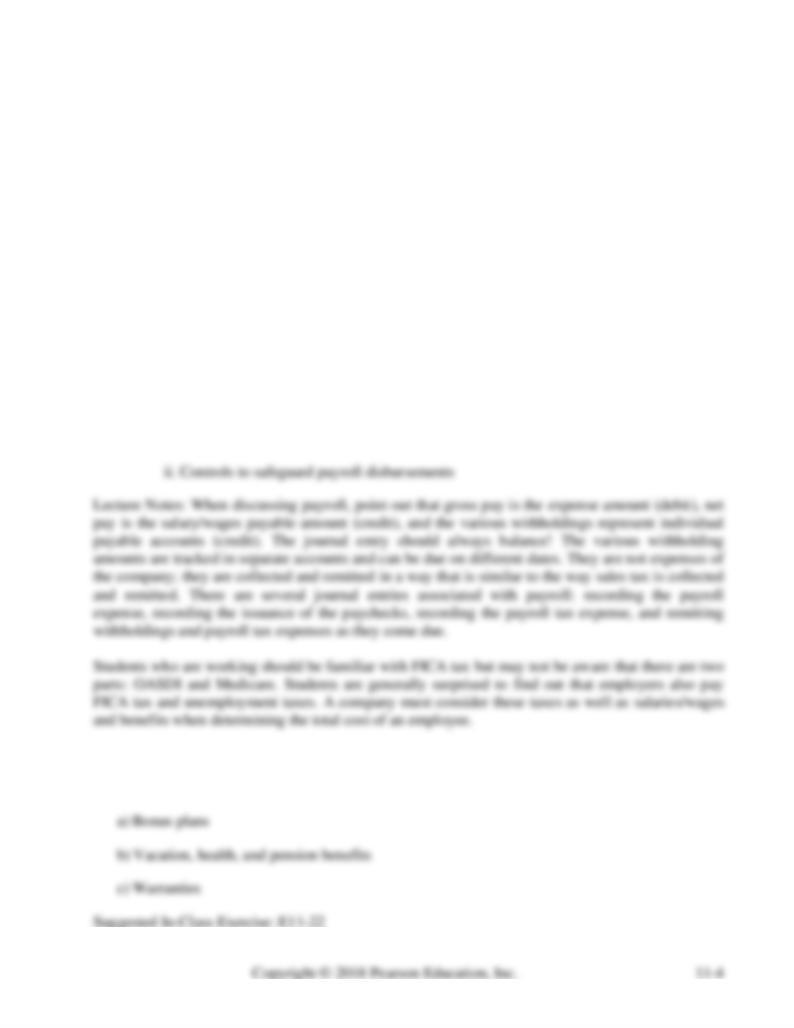
c) Payroll register
▪ Exhibit 11-2 Payroll Register
d) Journalizing employee payroll
e) Employer payroll taxes
i. Employer FICA tax
ii. State and federal unemployment compensation taxes
▪ Exhibit 11-3: Payroll Costs
iii. Journalizing employer payroll taxes
f) Payment of employer payroll taxes and employees’ withholdings
g) Internal control over payroll
i. Controls for efficiency
LO 3. Account for current liabilities that must be estimated
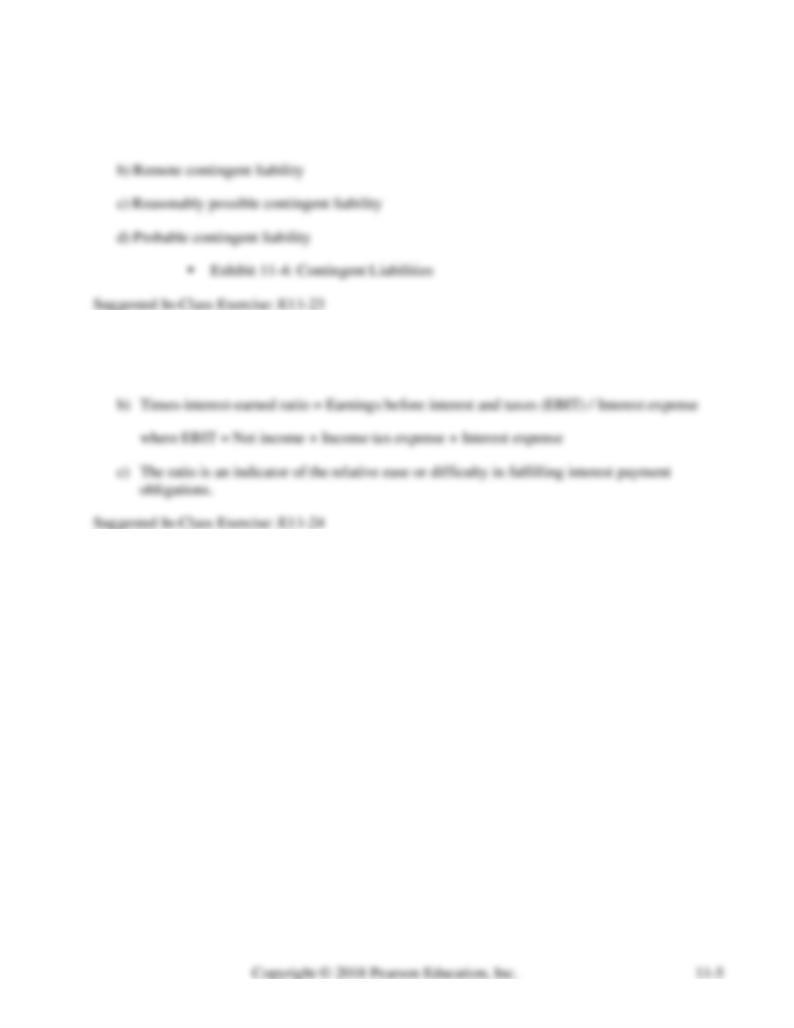
LO 4. Account for contingent liabilities
a) Contingent liability
LO 5. Use the times-interest-earned ratio to evaluate business performance
a) Also called the interest-coverage ratio
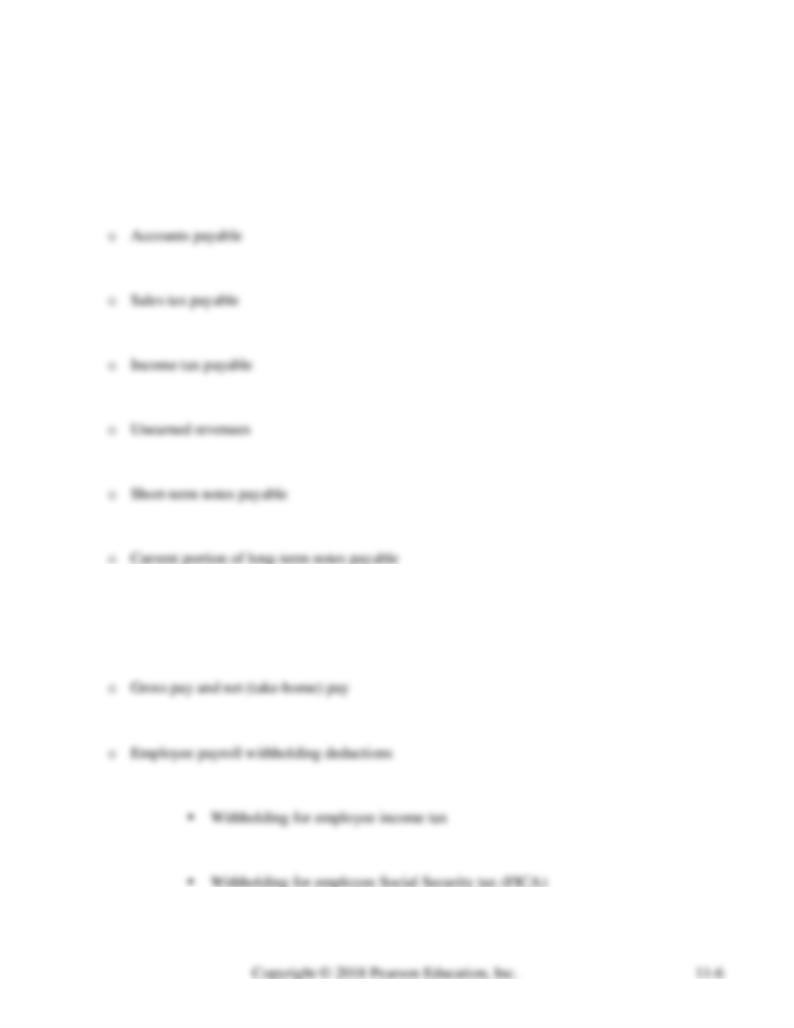
Chapter 11: Handout for Student Notes
LO 1. How are current liabilities of known amounts accounted for?
LO 2. How do companies account for and record payroll?
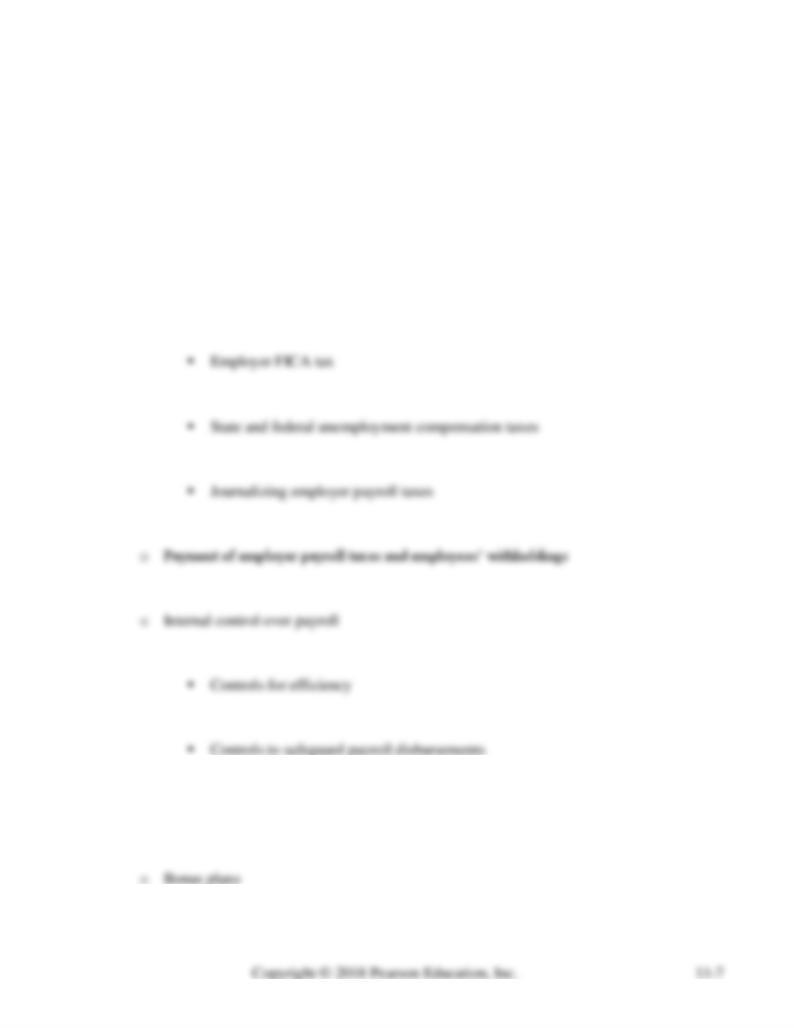
▪ Optional withholding deductions
o Payroll register
o Journalizing employee payroll
o Employer payroll taxes
LO 3. How are current liabilities that must be estimated accounted for?
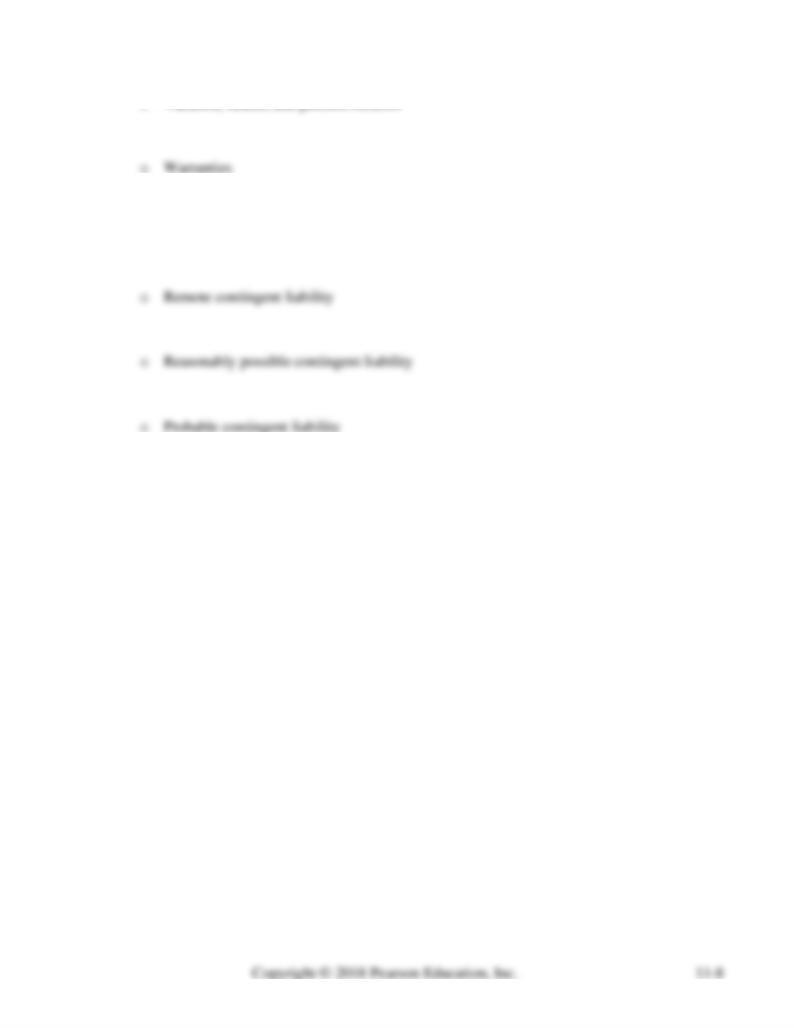
o Vacation, health, and pension benefits
LO 4. How are contingent liabilities accounted for?
LO 5. How do we use the times-interest-earned ratio to evaluate business performance?
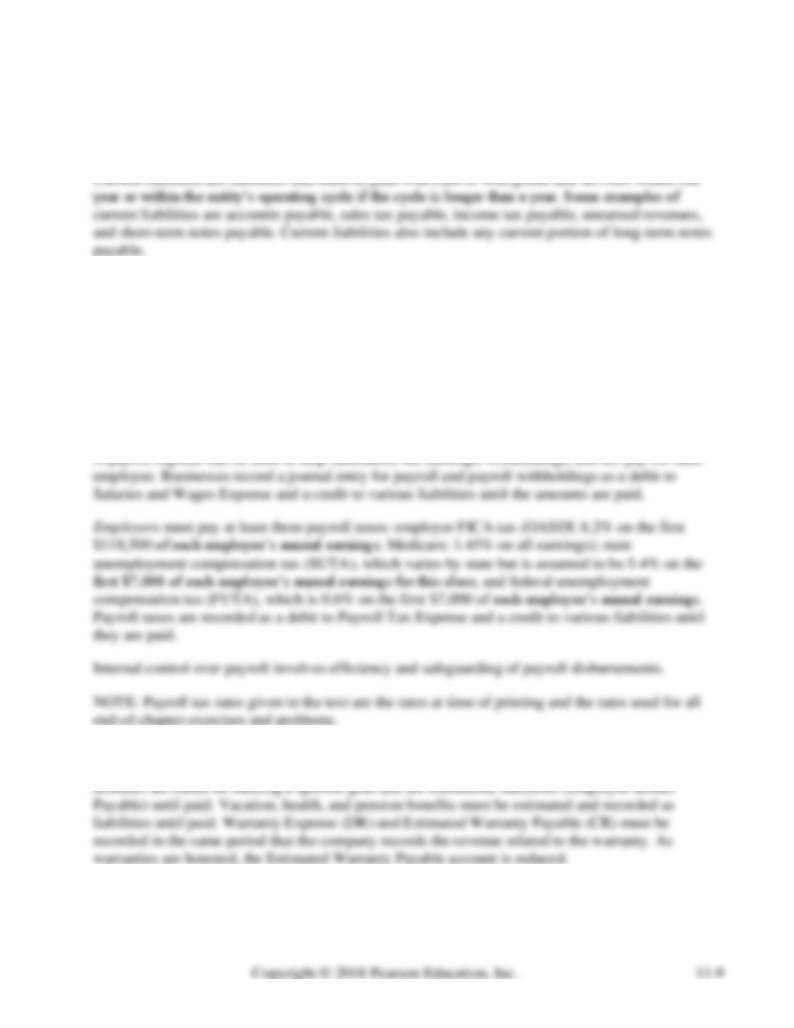
Chapter 11: Student Chapter Summary
LO 1. Account for current liabilities of known amount
LO 2. Calculate and journalize basic payroll transactions
Gross pay is the total amount of salary or wages earned by an employee. Net pay is the amount that
each employee gets to keep (take-home pay). Payroll withholding deductions are the difference
between gross pay and net pay. Examples of payroll deductions that employees pay include income
tax withholding (federal, state, and local income tax); employee FICA tax (OASDI: 6.2% on the first
$118,500 of annual earnings, Medicare: 1.45% on earnings up to $200,000 and 2.35% on all
earnings above $200,000); and optional withholdings (insurance premiums, retirement savings,
charitable contributions, union dues, and others).
LO 3. Account for current liabilities that must be estimated

LO 4. Account for contingent liabilities
A contingent liability is a potential liability that depends on some future event. Accounting for
contingent liabilities is based on the following likelihoods:
LO 5. Use the times-interest-earned ratio to evaluate business performance

Chapter 11: Assignment Grid and Other Materials
P11-29A, P11-34B
X
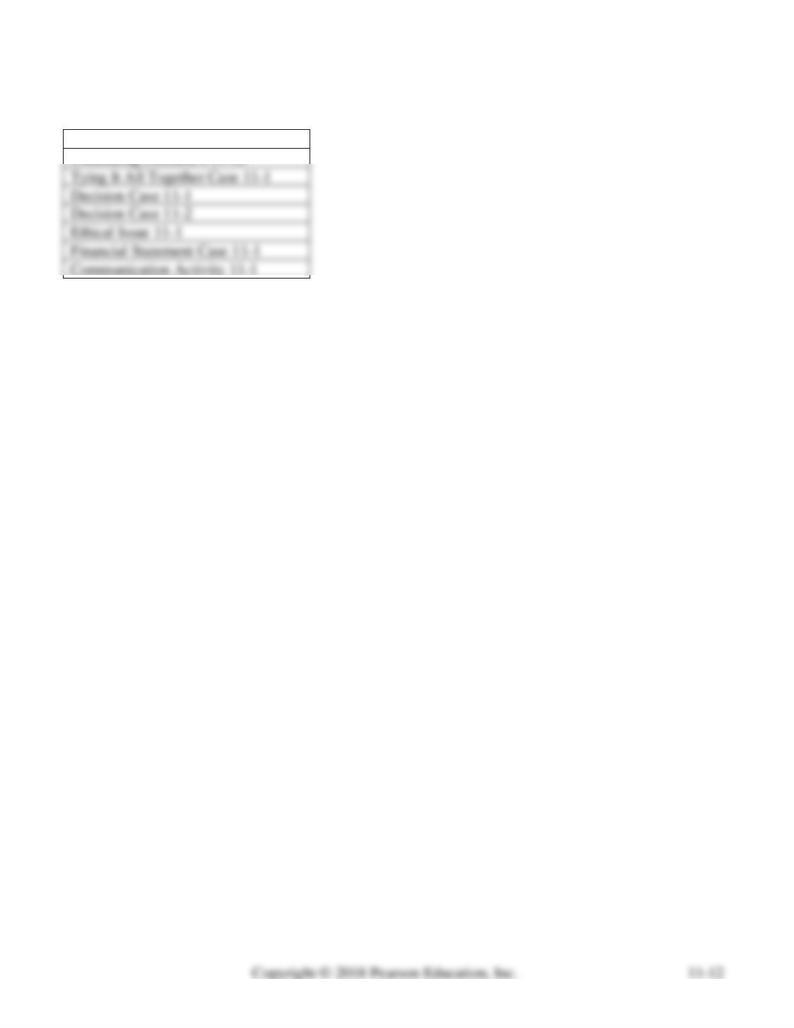
Other End-of-Chapter Materials:
Using Excel P11-35
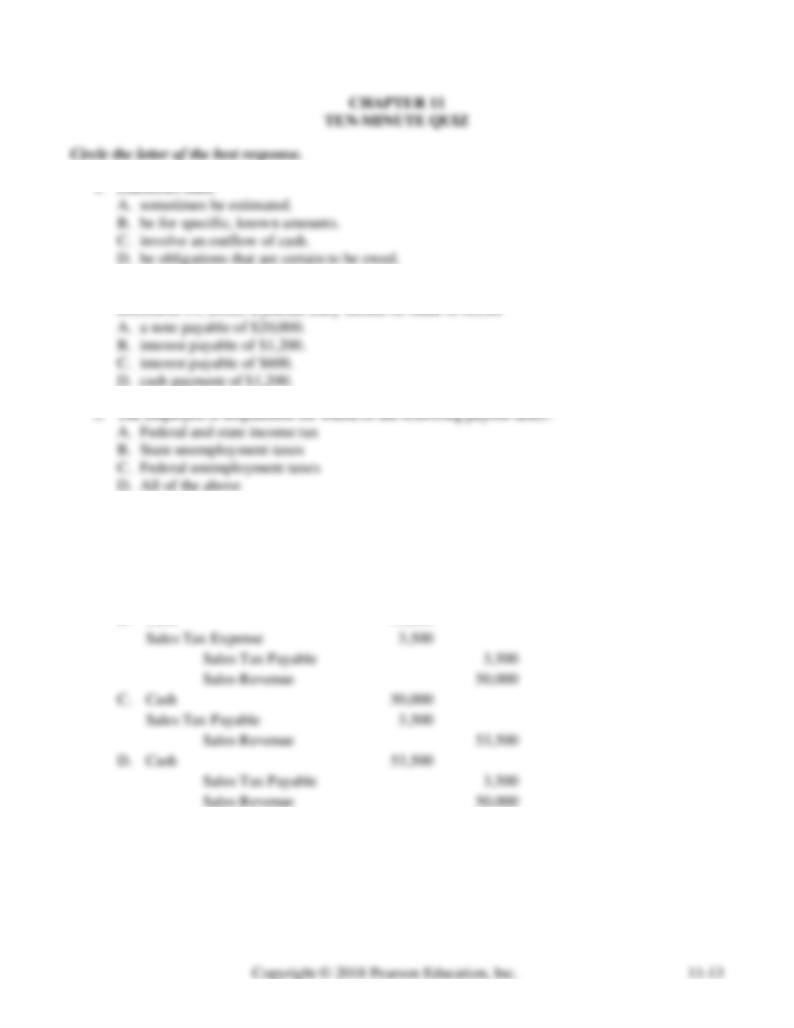
1. Liabilities must
2. On July 1, 20X8, your company borrowed $20,000 on a four-year, 6% note payable. At
3. The employee is responsible for which of the following payroll taxes?
4. Your company sells $50,000 of goods, and you collect sales tax of 7%. What is the journal entry
to record the transaction?
A.
Cash
50,000
Sales Tax Expense
3,500
Sales Revenue
53,500
B.
Cash
50,000
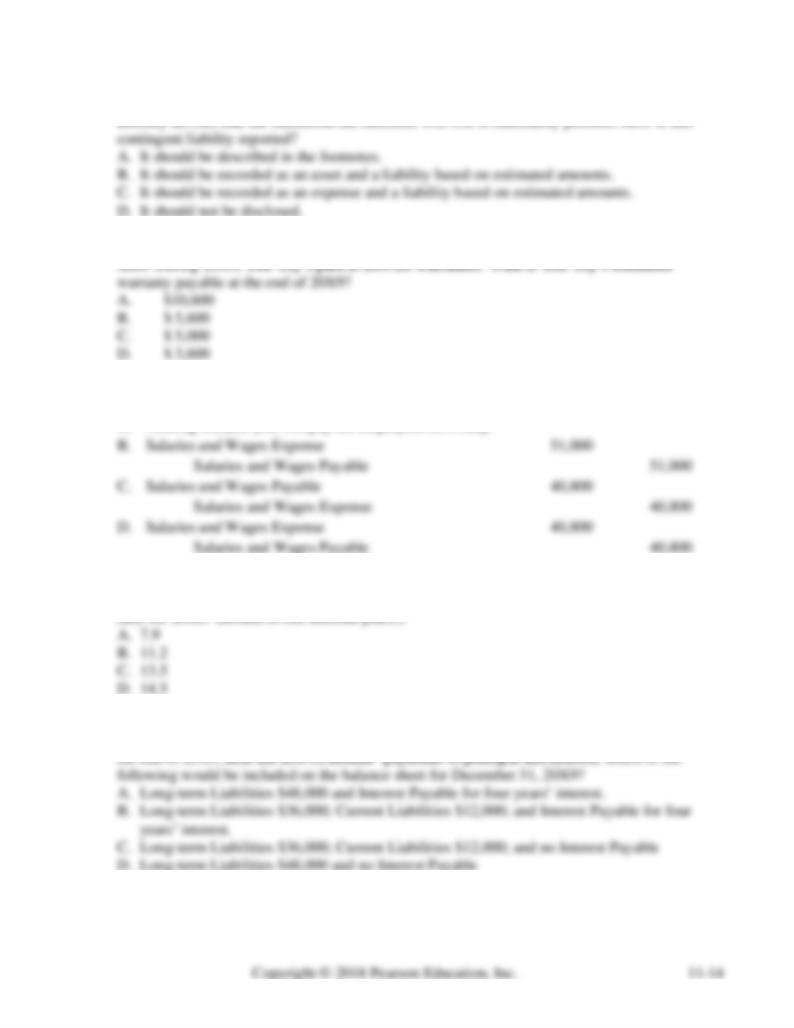
5. Cloud Company has a lawsuit pending from a customer claiming damages of $128,000. Cloud’s
6. Tots Toy’s owed Estimated Warranty Payable of $2,200 at the end of 20X8. During 20X9, Tots
Toy’s made sales of $280,000 and expects product warranties to cost the company 3% of the
7. At December 31, your company owes employees for four days of the five-day workweek. The
total payroll for the week is $51,000. What journal entry should you make at December 31?
A.
Nothing because you will pay the employees on Friday.
8. During 20X8, Crystal Glassware reported net income of $123,000, income tax expense of
$25,000, and interest expense of $11,000. What is Crystal Glassware’s times-interest-earned
9. As of January 1, 20X9, Darnell’s Deliveries owes $60,000 on a truck purchased for use by the
business. The company makes principal payments of $1,000 each month plus interest at 8%. At
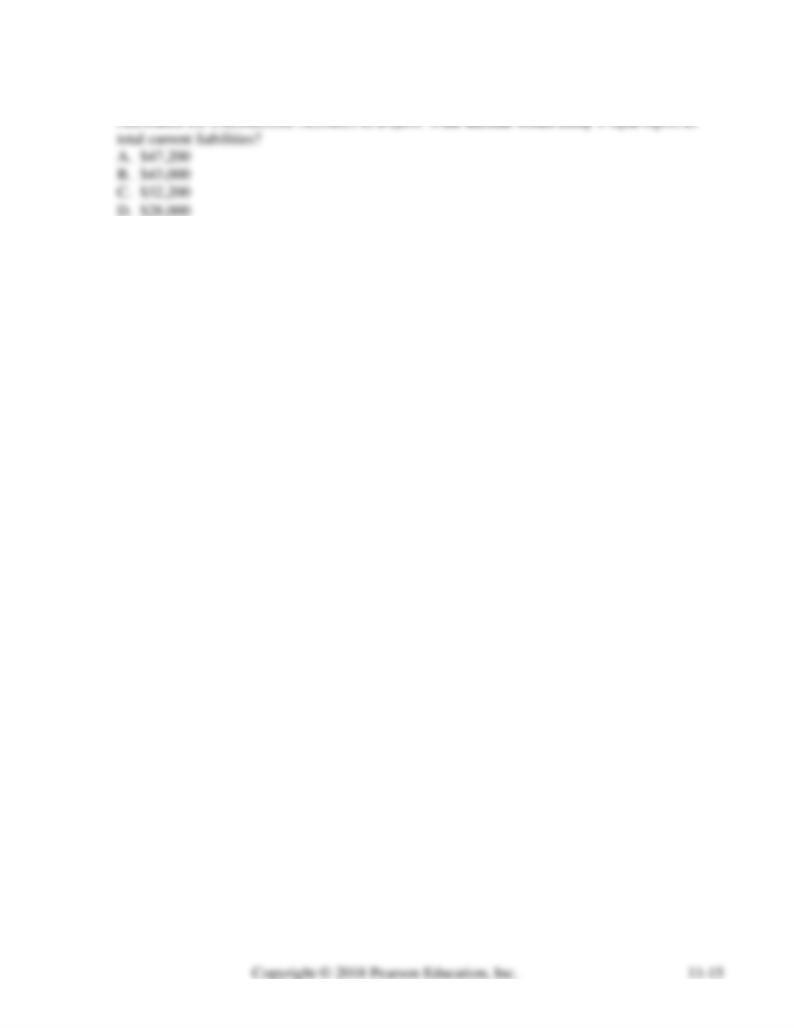
10. Rudy’s Fitness Gym has Unearned Revenue of $15,000, Salaries Payable of $28,000, and
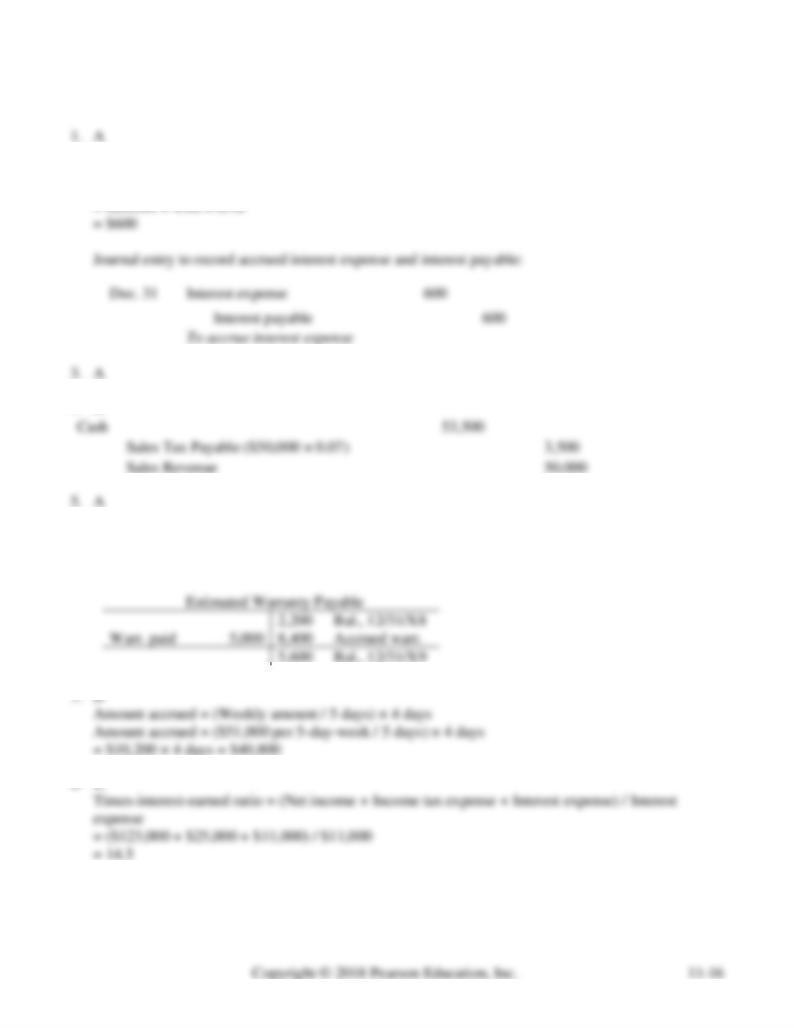
Answer Key to Ten-Minute Quiz:
2. C
Amount of interest = Principal × Interest rate × Time
4. D
6. B
Warranty expense = $280,000 × 0.03 = $8,400
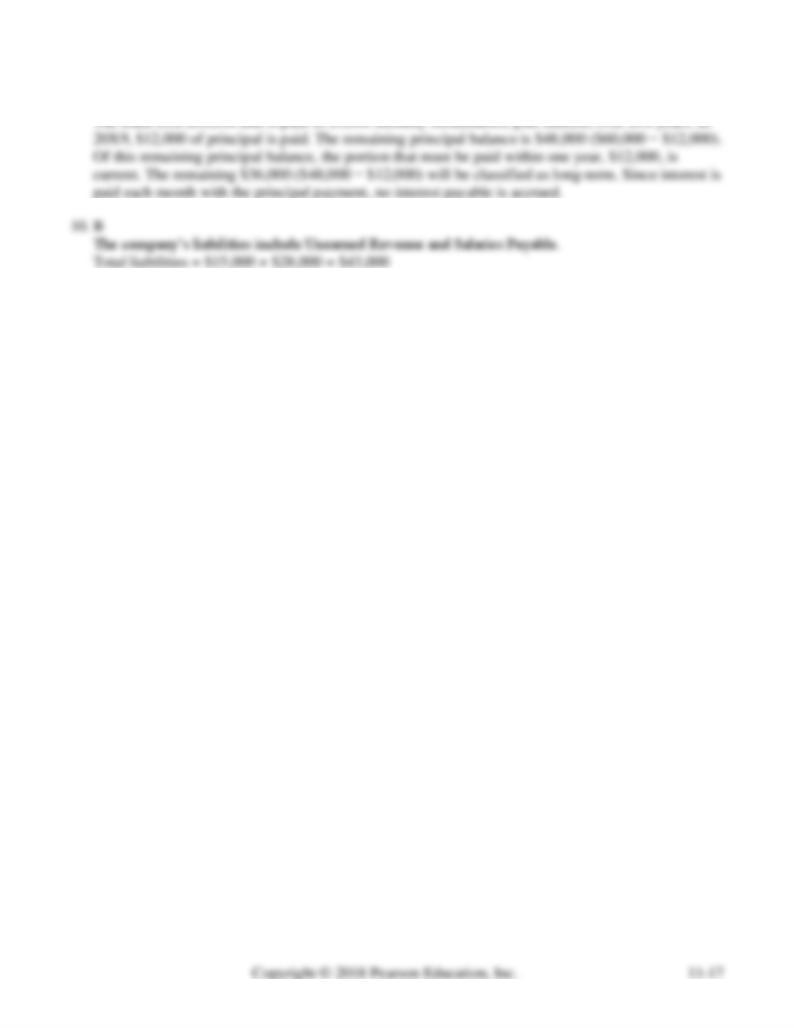
9. C
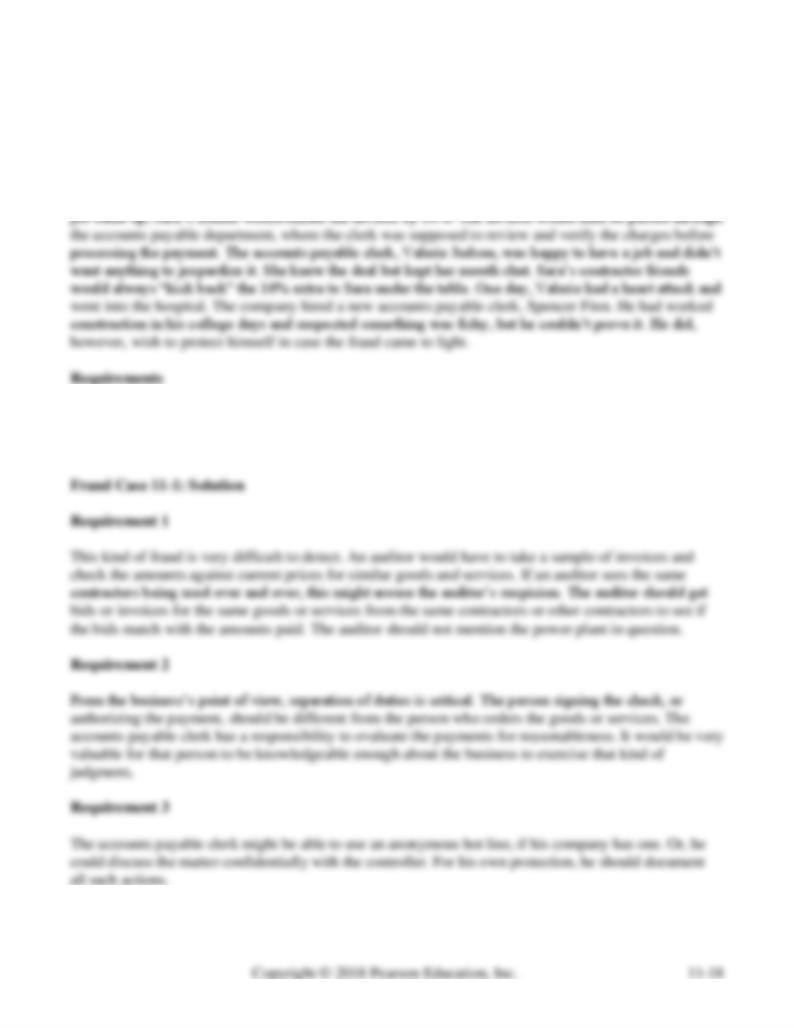
Extra Critical Thinking Questions
Fraud Case 11-1
Sara Chung knew the construction contractors in her area well. She was the purchasing manager at the
power plant, a business that was the major employer in the region. Whenever a repair or maintenance
1. How could an auditor detect fraud of this sort?
2. What can a business do to prevent this kind of fraudulent activity?
3. What should the new accounts payable clerk do to protect himself?

Team Project 11-1
In recent years, the airline industry has dominated headlines. Consumers are shopping Priceline.com and
other Internet sites for the lowest rates. The airlines have also lured customers with frequent-flyer
programs, which award free flights to passengers who accumulate specified miles of travel. Unredeemed
frequent-flyer mileage represents a liability that airlines must report on their balance sheets, usually as
Air Traffic Liability.
Southwest Airlines, a profitable, no-frills carrier based in Dallas, has been rated near the top of the
industry. Southwest controls costs by flying to smaller, less expensive airports; using only one model of
aircraft; serving no meals; increasing staff efficiency; and having a shorter turnaround time on the
ground between flights. The fact that most of the cities served by Southwest have predictable weather
maximizes its on-time arrival record.
With a partner or group, lead your class in a discussion of the following questions or write a report, as
directed by your instructor, answering the following questions: Frequent-flyer programs have grown into
significant obligations for airlines. Why should a liability be recorded for those programs? Discuss how
you might calculate the amount of this liability. Can you think of other industries that offer incentives
that create a similar liability?